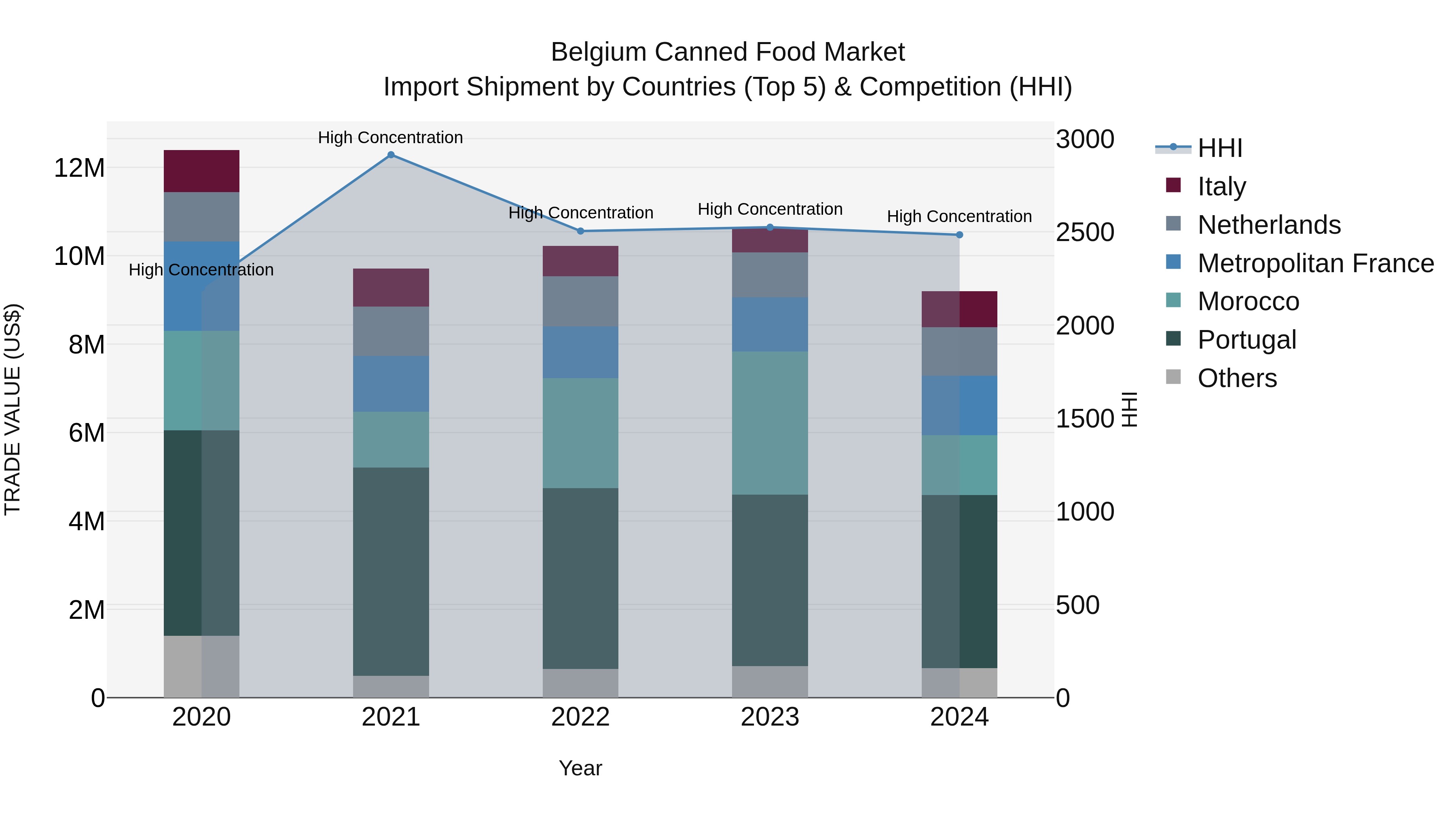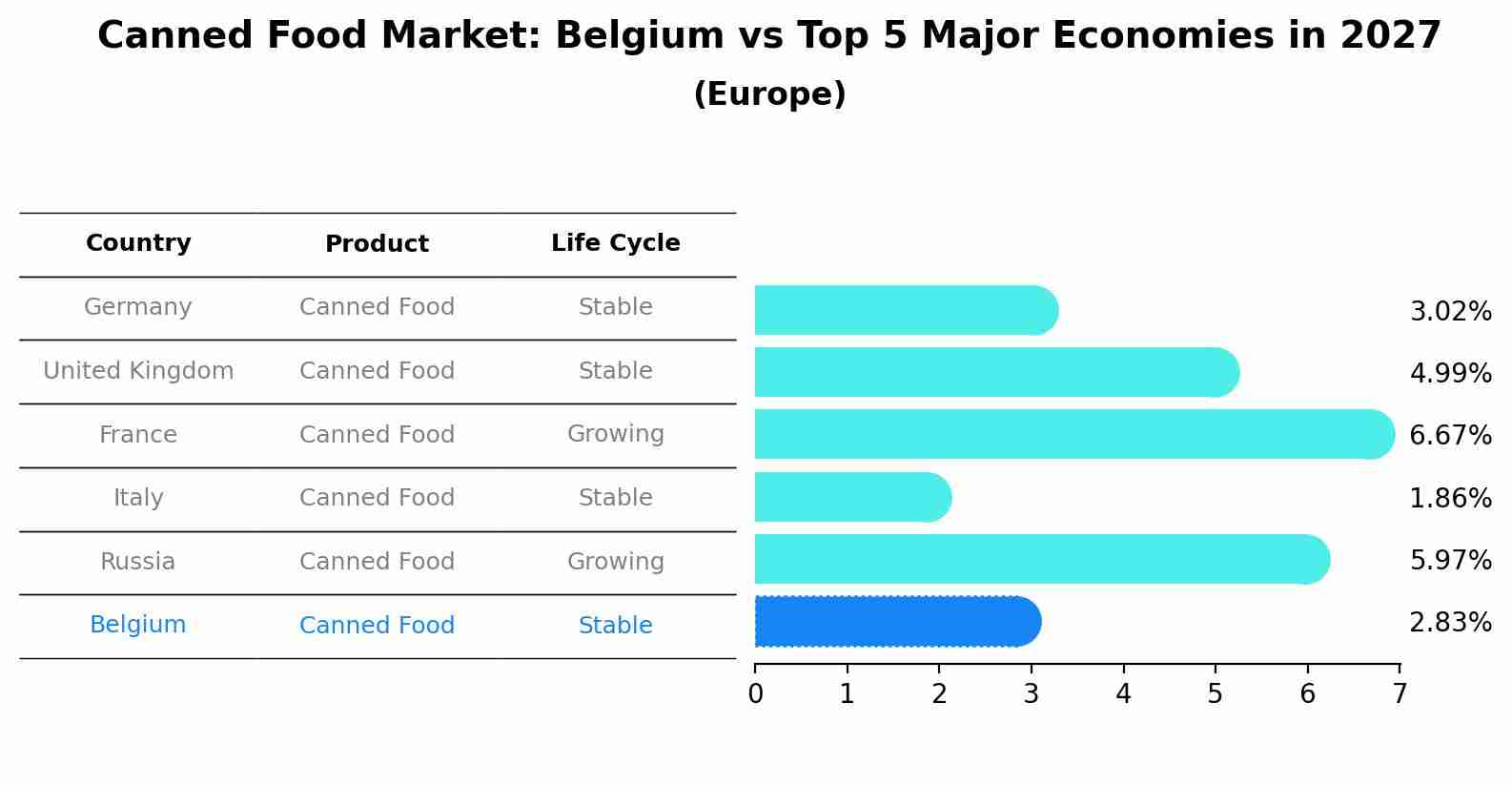Belgium Canned Food Market (2025-2031) | Revenue, Trends, Size, Analysis, Industry, Value, Share, Growth, Companies, Segmentation, Forecast & Outlook
| Product Code: ETC5007453 | Publication Date: Nov 2023 | Updated Date: Oct 2025 | Product Type: Market Research Report | |
| Publisher: 6Wresearch | Author: Sachin Kumar Rai | No. of Pages: 60 | No. of Figures: 30 | No. of Tables: 5 |
Belgium Canned Food Market Top 5 Importing Countries and Market Competition (HHI) Analysis
Despite the negative CAGR and growth rate in 2024, Belgium continues to import a significant amount of canned food products from top exporting countries like Portugal, Morocco, Metropolitan France, Netherlands, and Italy. The high Herfindahl-Hirschman Index (HHI) indicates a concentrated market, potentially offering opportunities for market consolidation or diversification strategies. Monitoring shifting trends in consumer preferences and exploring innovations in product offerings could help drive growth and competitiveness in the Belgian canned food import market.

Canned Food Market: Belgium vs Top 5 Major Economies in 2027 (Europe)
By 2027, the Canned Food market in Belgium is anticipated to reach a growth rate of 2.83%, as part of an increasingly competitive Europe region, where Germany remains at the forefront, supported by United Kingdom, France, Italy and Russia, driving innovations and market adoption across sectors.

Belgium Canned Food Market Overview
The canned food market in Belgium encompasses a wide range of products, including vegetables, fruits, meats, and ready-to-eat meals. This market is driven by consumer demand for convenient, long-lasting food options that require minimal preparation. Advances in canning technology have improved the nutritional quality and taste of canned foods, making them more appealing to health-conscious consumers. The market also benefits from busy lifestyles and the need for quick meal solutions. Environmental concerns are prompting the industry to adopt more sustainable packaging practices.
Drivers of the market
The overall canned food market in Belgium benefits from the demand for convenient, long-lasting food products. Canned foods offer a solution for consumers seeking quick meal options without compromising on nutrition. The market is also driven by innovations in canning technology that improve the taste and quality of canned products. Moreover, the increasing trend of stockpiling non-perishable foods, particularly during emergencies or uncertain times, supports market expansion.
Challenges of the market
The Belgium canned food market encounters challenges from evolving consumer preferences and regulatory standards. Consumers increasingly favor fresh and organic products, perceiving canned foods as less nutritious and less fresh. This shift necessitates innovation in preservation techniques and product offerings to meet health-conscious demands. Additionally, the market faces stiff competition from fresh, frozen, and ready-to-eat meal alternatives, which often boast superior taste and nutritional profiles. Regulatory pressures concerning food safety, labeling, and environmental impact of packaging materials add complexity and cost to operations. The industry also grapples with supply chain disruptions, particularly in sourcing quality raw materials and managing inventory efficiently.
Government Policy of the market
The broader canned food market in Belgium is driven by consumer demand for convenience and long shelf life. Government initiatives that focus on reducing food waste and promoting sustainable packaging have encouraged the growth of the canned food sector. Additionally, the adherence to EU food safety standards ensures that canned foods are of high quality and safe for consumption, further supporting market expansion.
Key Highlights of the Report:
- Belgium Canned Food Market Outlook
- Market Size of Belgium Canned Food Market, 2024
- Forecast of Belgium Canned Food Market, 2031
- Historical Data and Forecast of Belgium Canned Food Revenues & Volume for the Period 2021-2031
- Belgium Canned Food Market Trend Evolution
- Belgium Canned Food Market Drivers and Challenges
- Belgium Canned Food Price Trends
- Belgium Canned Food Porter`s Five Forces
- Belgium Canned Food Industry Life Cycle
- Historical Data and Forecast of Belgium Canned Food Market Revenues & Volume By Product Type for the Period 2021-2031
- Historical Data and Forecast of Belgium Canned Food Market Revenues & Volume By Canned meat & seafood for the Period 2021-2031
- Historical Data and Forecast of Belgium Canned Food Market Revenues & Volume By Canned fruit & vegetables for the Period 2021-2031
- Historical Data and Forecast of Belgium Canned Food Market Revenues & Volume By Canned ready meals for the Period 2021-2031
- Historical Data and Forecast of Belgium Canned Food Market Revenues & Volume By Others for the Period 2021-2031
- Historical Data and Forecast of Belgium Canned Food Market Revenues & Volume By Type for the Period 2021-2031
- Historical Data and Forecast of Belgium Canned Food Market Revenues & Volume By Organic for the Period 2021-2031
- Historical Data and Forecast of Belgium Canned Food Market Revenues & Volume By Conventional for the Period 2021-2031
- Historical Data and Forecast of Belgium Canned Food Market Revenues & Volume By Distribution Channel for the Period 2021-2031
- Historical Data and Forecast of Belgium Canned Food Market Revenues & Volume By Supermarket/Hypermarket for the Period 2021-2031
- Historical Data and Forecast of Belgium Canned Food Market Revenues & Volume By Convenience stores for the Period 2021-2031
- Historical Data and Forecast of Belgium Canned Food Market Revenues & Volume By E-commerce for the Period 2021-2031
- Historical Data and Forecast of Belgium Canned Food Market Revenues & Volume By Others for the Period 2021-2031
- Belgium Canned Food Import Export Trade Statistics
- Market Opportunity Assessment By Product Type
- Market Opportunity Assessment By Type
- Market Opportunity Assessment By Distribution Channel
- Belgium Canned Food Top Companies Market Share
- Belgium Canned Food Competitive Benchmarking By Technical and Operational Parameters
- Belgium Canned Food Company Profiles
- Belgium Canned Food Key Strategic Recommendations
Frequently Asked Questions About the Market Study (FAQs):
1 Executive Summary |
2 Introduction |
2.1 Key Highlights of the Report |
2.2 Report Description |
2.3 Market Scope & Segmentation |
2.4 Research Methodology |
2.5 Assumptions |
3 Belgium Canned Food Market Overview |
3.1 Belgium Country Macro Economic Indicators |
3.2 Belgium Canned Food Market Revenues & Volume, 2021 & 2031F |
3.3 Belgium Canned Food Market - Industry Life Cycle |
3.4 Belgium Canned Food Market - Porter's Five Forces |
3.5 Belgium Canned Food Market Revenues & Volume Share, By Product Type, 2021 & 2031F |
3.6 Belgium Canned Food Market Revenues & Volume Share, By Type, 2021 & 2031F |
3.7 Belgium Canned Food Market Revenues & Volume Share, By Distribution Channel, 2021 & 2031F |
4 Belgium Canned Food Market Dynamics |
4.1 Impact Analysis |
4.2 Market Drivers |
4.2.1 Increasing consumer demand for convenient and long-lasting food products |
4.2.2 Growing awareness about food safety and hygiene among consumers |
4.2.3 Rising popularity of ready-to-eat meals and snacks |
4.3 Market Restraints |
4.3.1 Competition from fresh and frozen food alternatives |
4.3.2 Concerns regarding the nutritional value and health impact of canned foods |
4.3.3 Fluctuating raw material prices affecting production costs |
5 Belgium Canned Food Market Trends |
6 Belgium Canned Food Market Segmentations |
6.1 Belgium Canned Food Market, By Product Type |
6.1.1 Overview and Analysis |
6.1.2 Belgium Canned Food Market Revenues & Volume, By Canned meat & seafood, 2021-2031F | 6.1.4 Belgium Canned Food Market Revenues & Volume, By Canned fruit & vegetables, 2021-2031F |
6.1.4 Belgium Canned Food Market Revenues & Volume, By Canned ready meals, 2021-2031F |
6.1.5 Belgium Canned Food Market Revenues & Volume, By Others, 2021-2031F |
6.2 Belgium Canned Food Market, By Type |
6.2.1 Overview and Analysis |
6.2.2 Belgium Canned Food Market Revenues & Volume, By Organic, 2021-2031F |
6.2.3 Belgium Canned Food Market Revenues & Volume, By Conventional, 2021-2031F |
6.3 Belgium Canned Food Market, By Distribution Channel |
6.3.1 Overview and Analysis |
6.3.2 Belgium Canned Food Market Revenues & Volume, By Supermarket/Hypermarket, 2021-2031F |
6.3.3 Belgium Canned Food Market Revenues & Volume, By Convenience stores, 2021-2031F |
6.3.4 Belgium Canned Food Market Revenues & Volume, By E-commerce, 2021-2031F |
6.3.5 Belgium Canned Food Market Revenues & Volume, By Others, 2021-2031F |
7 Belgium Canned Food Market Import-Export Trade Statistics |
7.1 Belgium Canned Food Market Export to Major Countries |
7.2 Belgium Canned Food Market Imports from Major Countries |
8 Belgium Canned Food Market Key Performance Indicators |
8.1 Consumer satisfaction ratings related to the taste and quality of canned food products |
8.2 Number of new product launches and innovations in the canned food market |
8.3 Percentage of repeat purchases by consumers |
8.4 Environmental sustainability practices adopted by canned food manufacturers |
9 Belgium Canned Food Market - Opportunity Assessment |
9.1 Belgium Canned Food Market Opportunity Assessment, By Product Type, 2021 & 2031F |
9.2 Belgium Canned Food Market Opportunity Assessment, By Type, 2021 & 2031F |
9.3 Belgium Canned Food Market Opportunity Assessment, By Distribution Channel, 2021 & 2031F |
10 Belgium Canned Food Market - Competitive Landscape |
10.1 Belgium Canned Food Market Revenue Share, By Companies, 2024 |
10.2 Belgium Canned Food Market Competitive Benchmarking, By Operating and Technical Parameters |
11 Company Profiles |
12 Recommendations | 13 Disclaimer |
- Single User License$ 1,995
- Department License$ 2,400
- Site License$ 3,120
- Global License$ 3,795
Search
Thought Leadership and Analyst Meet
Our Clients
Related Reports
- Afghanistan Apparel Market (2026-2032) | Growth, Outlook, Industry, Segmentation, Forecast, Size, Companies, Trends, Value, Share, Analysis & Revenue
- Canada Oil and Gas Market (2026-2032) | Share, Segmentation, Value, Industry, Trends, Forecast, Analysis, Size & Revenue, Growth, Competitive Landscape, Outlook, Companies
- Germany Breakfast Food Market (2026-2032) | Industry, Share, Growth, Size, Companies, Value, Analysis, Revenue, Trends, Forecast & Outlook
- Australia Briquette Market (2025-2031) | Growth, Size, Revenue, Forecast, Analysis, Trends, Value, Share, Industry & Companies
- Vietnam System Integrator Market (2025-2031) | Size, Companies, Analysis, Industry, Value, Forecast, Growth, Trends, Revenue & Share
- ASEAN and Thailand Brain Health Supplements Market (2025-2031) | Strategy, Consumer Insights, Analysis, Investment Trends, Opportunities, Growth, Size, Share, Industry, Revenue, Segments, Value, Segmentation, Supply, Forecast, Restraints, Outlook, Competition, Drivers, Trends, Demand, Pricing Analysis, Competitive, Strategic Insights, Companies, Challenges
- ASEAN Bearings Market (2025-2031) | Strategy, Consumer Insights, Analysis, Investment Trends, Opportunities, Growth, Size, Share, Industry, Revenue, Segments, Value, Segmentation, Supply, Forecast, Restraints, Outlook, Competition, Drivers, Trends, Demand, Pricing Analysis, Competitive, Strategic Insights, Companies, Challenges
- Europe Flooring Market (2025-2031) | Outlook, Share, Industry, Trends, Forecast, Companies, Revenue, Size, Analysis, Growth & Value
- Saudi Arabia Manlift Market (2025-2031) | Outlook, Size, Growth, Trends, Companies, Industry, Revenue, Value, Share, Forecast & Analysis
- Uganda Excavator, Crane, and Wheel Loaders Market (2025-2031) | Strategy, Consumer Insights, Analysis, Investment Trends, Opportunities, Growth, Size, Share, Industry, Revenue, Segments, Value, Segmentation, Supply, Forecast, Restraints, Outlook, Competition, Drivers, Trends, Demand, Pricing Analysis, Competitive, Strategic Insights, Companies, Challenges
Industry Events and Analyst Meet
Whitepaper
- Middle East & Africa Commercial Security Market Click here to view more.
- Middle East & Africa Fire Safety Systems & Equipment Market Click here to view more.
- GCC Drone Market Click here to view more.
- Middle East Lighting Fixture Market Click here to view more.
- GCC Physical & Perimeter Security Market Click here to view more.
6WResearch In News
- Doha a strategic location for EV manufacturing hub: IPA Qatar
- Demand for luxury TVs surging in the GCC, says Samsung
- Empowering Growth: The Thriving Journey of Bangladesh’s Cable Industry
- Demand for luxury TVs surging in the GCC, says Samsung
- Video call with a traditional healer? Once unthinkable, it’s now common in South Africa
- Intelligent Buildings To Smooth GCC’s Path To Net Zero


















